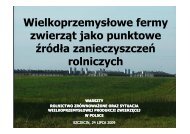best available technologies for manure treatment - Baltic Green Belt
best available technologies for manure treatment - Baltic Green Belt
best available technologies for manure treatment - Baltic Green Belt
Create successful ePaper yourself
Turn your PDF publications into a flip-book with our unique Google optimized e-Paper software.
Best Available Technologies <strong>for</strong> <strong>manure</strong> <strong>treatment</strong> baltic sea 2020<br />
Best Available Technologies <strong>for</strong> <strong>manure</strong> <strong>treatment</strong> baltic sea 2020<br />
ANNEX E: TABLES WITH SHORT DESPRIPTION OF LIVESTOCK MANURE TREATMENT TECHNOLOGIES<br />
Best Available Techniques <strong>for</strong> <strong>manure</strong> <strong>treatment</strong> - <strong>for</strong> intensive rearing of pigs in <strong>Baltic</strong> Sea Region EU Member States Technical Report "Best Practice Manure Handling, Phase 2"<br />
Ref No. 41 Composting<br />
Brief description<br />
Composting of solid <strong>manure</strong> is a <strong>for</strong>m of aerobic <strong>treatment</strong> which can occur naturally in livestock <strong>manure</strong><br />
heaps. High porosity (30 – 50 %) is required <strong>for</strong> sufficient aeration.<br />
Temperatures in the compost heap are between 50 and 70 ºC and kill most of the pathogens. Compost<br />
with a dry matter of up to 85 % can be produced. Suitability <strong>for</strong> application depends on the structure of the<br />
<strong>manure</strong>, but requires a minimum dry matter content of 20 %. Typical livestock <strong>manure</strong> heaps do not satisfy<br />
the requirements <strong>for</strong> thorough composting. With controlled application, <strong>manure</strong> is composted in stacks of<br />
a size that suits the aerobic conditions and the use of machinery.<br />
Best results are obtained by using well-chopped straw and solid <strong>manure</strong> in the right proportions and by<br />
controlling temperature and moisture content in long narrow ‘windrows’. Composting can also be<br />
per<strong>for</strong>med in a barn (e.g. pre-dried <strong>manure</strong>). Specific systems have been developed that consist of a<br />
combination of tanks with aeration and stirring equipment to enhance the fermentation process and<br />
containers or boxes <strong>for</strong> further fermentation and drying. Properly composted solid <strong>manure</strong> significantly<br />
reduces the volume of material spread to land and the amount of odour released. For easier handling,<br />
pelletizing is applied in addition to composting.<br />
Description of the effect on leaching (positive or negative) of N<br />
and P<br />
Composting is done in order to make livestock <strong>manure</strong> stable,<br />
i.e. able to transport and store without further moulding or<br />
fermenting, without seeping, and without evaporations.<br />
Further, the purpose of composting comprises advantages as<br />
being a cheap way to reduce the water amount, and a<br />
possibility to kill weed seeds and pathogens.<br />
The effect on leaching is negative: Barrington et al. (2002)<br />
have reported that N losses from pig/straw <strong>manure</strong> through<br />
seepage is between 12 and 22%, and that further 31 to 57% N<br />
is lost during the composting as emissions of N<br />
2<br />
and N<br />
2<br />
O, in<br />
total a loss of 53 to 69% of the N.<br />
Composting of livestock <strong>manure</strong> in closed containers would<br />
probably make the economy in this technology even worse.<br />
Innovation stage<br />
Research<br />
Pilot<br />
Practice <br />
Major references<br />
Ministry of<br />
Agriculture, Food<br />
and Fisheries. 1996<br />
Barrington et al.,<br />
2002<br />
Investment price, <br />
Basic Variable<br />
For a composting plant that treats<br />
2,000 tonnes <strong>manure</strong> with 1,360<br />
tonnes sawdust and producing 1,800<br />
tonnes compost:<br />
For a turned windrow system, an<br />
appropriate tractor and turner<br />
could easily cost 35,000 to <br />
40,000.<br />
If buildings are constructed <strong>for</strong><br />
all four activities (mixing,<br />
composting, curing and storage),<br />
total construction costs could be<br />
82,000 to 100,000 <strong>for</strong> an<br />
operation of this size.<br />
Condition <strong>for</strong> leaching reduction<br />
effect<br />
Composting has no leaching<br />
reduction effect – on the contrary,<br />
the process itself is often reason <strong>for</strong><br />
leaching.<br />
No data<br />
Operational costs,<br />
per tonnes<br />
Around 20 as an<br />
average,<br />
depending on the<br />
efficiency.<br />
Certainty of in<strong>for</strong>mation<br />
Prices Low<br />
Effect on leaching High<br />
per kg saved N<br />
or P leaching<br />
The question<br />
cannot be<br />
answered because<br />
there is a negative<br />
effect on the<br />
leaching.<br />
Complexity of implementation<br />
Composting can be organised on every farm,<br />
however, there exists more advanced and industrial<br />
composting <strong>technologies</strong>, which probably have a large<br />
economy of scale.<br />
64<br />
Page 65<br />
64








